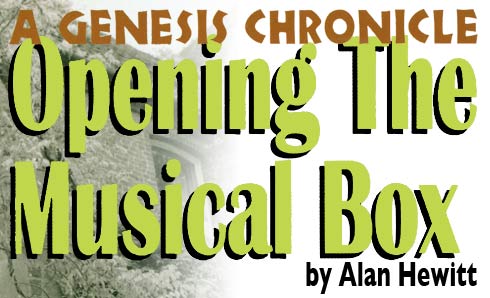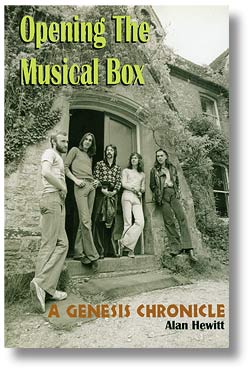- Article
- Read in 4 minutes
Genesis – Alan Hewitt: Opening the musical box – book review
Alan Hewitt’s book offers a rapid introduction to the world of Genesis. He introduces the major events as well as all members of the band, providing a relatively comprehensive biography. A special feature of this book is a table of tour dates as they were known at the time the book was prepared for printing.

Genesis fans had to wait for a long time for a comprehensive biography of their favourite band. Now that the future of the band is uncertain and Archive #2 has perhaps been released as the band’s final chapter, the time is ripe for such a book. But what should it look like? Every single band member is worth a separate biography. Nobody could buy a complete biography of the band because the wealth of information would make it too long and too expensive. A shorter approach may lack content to be really good. Alan Hewitt’s book is an attempt at a compromise. It does not claim to be complete, but it wants to explain the most important events, briefly introduce each member of the band and present a comparatively complete discography. One could almost describe it as a fast introduction to the world of Genesis, but then there are chapters with far too many details.
After numerous thank-yous to helpers and an introduction about his project and the development of the book there is a brief history of the band and its members outlined in brief notes. The first mistakes occur here already – Gabriel’s first single was Solsbury Hill, not Moribund The Burgermeister and We Can’t Dance was released on November 21, not November 11, 1991. These are minor details, but they should have been got right. The timeline is a good idea, but where does one draw the line and say “this is important”, “that can be left out”? That is the weak point of the timeline. In the following chapters Hewitt tells the history of the band. The events from the late 70s onwards are presented in a very condensed form so that one notices he is a fan of the early Genesis. Hewitt fluently tells the story of the band and it is fun to read it even though a real fan knows all this already. Unfortunately, more mistakes make their appearance. We Can’t Dance was at #1 in the German charts for 24 weeks, not for a mere 16 weeks. Again, it’s a minor detail, but it’s the little things that make the difference between a “neutral” account and a “fan bible”. The ensuing discography provides a musical and statistical overview.
 The next chapters can never be complete, not least because every fan
The next chapters can never be complete, not least because every fan
will have a different definition for it. Hewitt lists some “collectable
recordings” before the turns to memorabilia in the following chapter.
While the “collectable recordings” are about rare originals of official
releases, the memorabilia chapter is occupied with tour programmes,
books, fanzines, videos – and also bootlegs. Don’t worry, completeness
has not even been attempted, but then the selection is somewhat meagre.
It looks like a random excerpt from Hewitt’s own collection. Some firm
criteria such as “complete shows only” or “radio / soundboard
recordings only” would have been better. Once again we are facing the
problem of the compromise. It is a good thing, though, that solo
material is included. Of course that’s another area that can never be
complete. A service for the fan is the listing of various established
fanclubs with the mailing addresses and internet links.
Then there is the solo department. Separate chapters are devoted to
each band member (except for Ray Wilson) and an account of their solo
careers. Each chapter is followed by the obligatory discography of
official releases. More mistakes appear, ranging from forgivable (Only
You And I Know instead of Only You Know And I Know) to embarrassing.
Dance Into The Light is Phil’s sixth solo album, not his fifth (even if
you only count the studio recordings). A well-known fan like Alan
Hewitt should pay more attention to such matters. Still, every
biography has a special flavour that fits the individual characters.
That certainly is a talent of Hewitt’s. There is not a single boring
page in the book.
An appendix of some 70 pages lists all the quotes of the book. More
interesting, though, is the (certainly incomplete) listing of tour
dates that goes quite some way in the direction of flawless research.
Even the solo tours are listed. A great feat – one can even look up
postponed and cancelled dates.
 A compromise is a difficult thing. On the one hand this book is very
A compromise is a difficult thing. On the one hand this book is very
entertaining, which is a good thing with books of this kind. On the
other hand we always feel that there is something missing or that there
is more to come. There is a striking imbalance between the accounts of
Gabriel-era Genesis and Collins-era Genesis. It is not surprising
either that the chapter about Anthony Phillips’ solo career is the
longest (15 pages) of the solo chapters if you consider that Alan
Hewitt is a big fan of Phillip’s music. He ought to be able to explain
whether the length of the chapters corresponds to the importance of the
artist for the band, though.
Opening The Musical Box is nevertheless very worthwhile reading. Works
like these cannot be expected from free-lance journalists. It would be
presumptuous to demand such a comprehensive book about every single
member of the band. But, to be honest – that would be great! We’d all
be happy, except for Alan Hewitt who would then probably be a nervous
wreck. See for yourselves. It’s written in the book!
by Christian Gerhardts, February 2001
photo by Helmut Janisch
translated by Martin Klinkhardt

